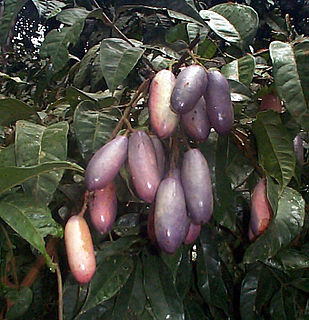
Dacryodes is a genus of about 60 species of trees in the family Burseraceae. The generic name is from the Greek dakruon meaning "tear(drop)", referring to how resin droplets form on the bark surface.
Helicia excelsa is a plant in the family Proteaceae. It grows as a tree up to 20 metres (70 ft) tall, with a trunk diameter of up to 25 centimetres (10 in). The bark is dark grey to blackish. Inflorescences bear up to three reddish brown flowers. Fruit is black, ellipsoid, up to 3 centimetres (1 in) long. The specific epithet excelsa is from the Latin meaning "lofty", referring to the tree's growth. Habitat is forests from sea level to 1,700 metres (5,600 ft) altitude. H. excelsa is found in Bangladesh, Burma, Thailand, Malaysia and Indonesia.
Dysoxylum arborescens is a tree in the family Meliaceae. The specific epithet arborescens is from the Latin meaning "tree-like".
Dysoxylum excelsum is a tree in the family Meliaceae. The specific epithet excelsum is from the Latin meaning "tall".
Canarium apertum is a tree in the family Burseraceae. The specific epithet apertum is from the Latin meaning "open", referring to the basal openings between petals.
Canarium grandifolium is a tree in the family Burseraceae. The specific epithet grandifolium is from the Latin meaning "large leaf".
Canarium merrillii is a tree in the family Burseraceae. It is named for the American botanist Elmer Drew Merrill.
Canarium denticulatum is a tree in the family Burseraceae. The specific epithet denticulatum is from the Latin meaning "small teeth", referring to the leaf margin.
Dacryodes costata is a tree in the family Burseraceae. The specific epithet costata is from the Latin meaning "ribbed", likely referring to the prominent veins on the leaf underside.
Dacryodes elmeri is a tree in the family Burseraceae. It is named for the American botanist Adolph Elmer.
Dacryodes expansa is a tree in the family Burseraceae. The specific epithet expansa is from the Latin meaning "spread out", referring to the structure of the petals.
Dacryodes incurvata is a tree in the family Burseraceae. The specific epithet incurvata is from the Latin meaning "bending inward", referring to the leaflet margin.
Dacryodes laxa is a tree in the family Burseraceae. The specific epithet laxa is from the Latin meaning "loose", referring to the inflorescence.
Dacryodes longifolia is a tree in the family Burseraceae. The specific epithet longifolia is from the Latin meaning "long leaf".
Dacryodes macrocarpa is a tree in the family Burseraceae. The specific epithet macrocarpa is from the Greek meaning "large fruit".
Dacryodes nervosa is a tree in the family Burseraceae. The specific epithet nervosa is from the Latin meaning "with nerves", referring to the leaves.

Dacryodes rostrata is a tree in the family Burseraceae. The specific epithet rostrata is from the Latin meaning "beaked", referring to the narrow-tipped leaves.
Dacryodes rubiginosa is a tree in the family Burseraceae. The specific epithet rubiginosa is from the Latin meaning "rust-coloured", referring to the tomentum.
Dacryodes rugosa var. virgata is a tree in the family Burseraceae.
Mastixia cuspidata is a tree in the family Nyssaceae. The specific epithet cuspidata is from the Latin meaning "sharp-pointed", referring to the leaf apex.

